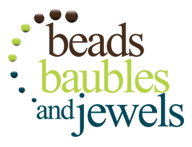 |
www.beadsbaublesandjewels.com BBJ – the source for jewelry making, beading, and metal work: instructions, education and projects from leading jewelry designers, and instructors. The online home of the public television program. |
| 1801-4 | Print | Close [X] |
| Kate Richbourg has the first of her metal work lessons and beginning steps for soldering. |
For More Information Visit: www.beadingdaily.com |
Materials: Silver paste solder or metal solder and flux. Solder Paste solder is powdered metal solder suspended in a thick paste flux. The flux acts as a temporary adhesive, holding the components in place until the soldering process melts the solder to create the join. Flux also allows the molten alloy to flow. Without the addition of flux the solder would ball up on the surface and not flow to form a join. Paste solder is convenient for simple soldering applications including jump rings since it stays put and is easy and quick to apply. It is hard to control where solder paste flows, so special attention must be paid to the amount applied and where it is placed. Wire or sheet solder is easier to control, but requires more patience to use. A separate layer of paste or liquid flux must be applied to the surface of the metal and then small pieces of solder (pallions) are placed along the join. Always work on a fireproof surface such as a metal cookie sheet or other piece of sheet metal. A cookie sheet has the advantage of having an edge to prevent any hot material from rolling off onto you or the floor. Butane Torch The butane torch is the basic tool for jewelry soldering. When handled properly, butane torches are quite safe and easy to use, but it is always best to take precautions when using any type of flame. Please read all the safety instructions below, as well as those that may come with your torch before filling it or turning it on. To fill the torch, locate the valve on the bottom. Insert the tip of the butane canister into the torch and press down to dispense the fuel. The torch is full when the butane sputters around the valve. Wait at least one minute after filling to let the gas settle before turning on the torch. Most butane torches have a Piezo ignition. This type of ignition consists of a small, spring-loaded hammer that hits a quartz crystal when the ignition button is pressed, creating a spark which ignites the gas. To turn the torch on, locate the switch or lever that starts the butane flow and press the ignition button. Some torches have a safety switch that must be pushed before the torch can be ignited. To turn off the torch, turn off the the butane flow and the flame will extinguish. Torch Safety tip: Always wear safety glasses and have a fire extinguisher handy. Tie long hair back and avoid loose clothing and open-toed shoes. Work in a well-ventilated area. Do not light the torch facing away from the soldering area and then swing it towards Pickle The purpose of pickle is to remove firescale, an oxidation that forms on the surface of metal after it has been heated. Firescale must be removed between each soldering step because solder will only adhere to clean metal. Pickle is made from a granulated acid and is produced under many brand names. Sparex, for example is a brand name for sodium bisulphate, a common pool additive that also makes an excellent pickle. Use copper or plastic utensils to remove the pieces from the pickle, as steel will contaminate the solution. To make a pickle solution, mix 1 part granular pickle and 8 parts water in a heatedcrock pot. Penny Brite is the brand name for a citric acid based metal polish that is also very effective on firescale. Use the sponge that comes with the polish to scrub the firescale until it is completely removed. Rinse the piece completely. Both solutions are for all non-ferrous metals. (Sterling Silver, Copper, Brass and Nickel) For more information about Kate Richbourg visit: katerichbourg.blogspot.com
|
Kate Richbourg & Katie Hacker |